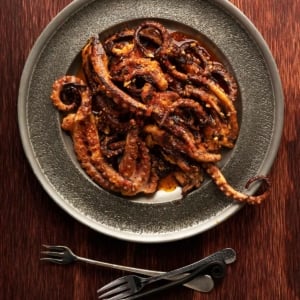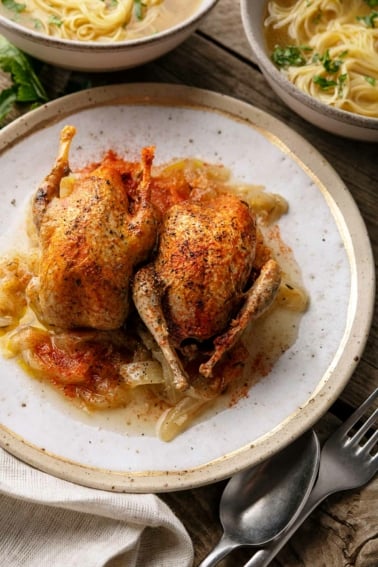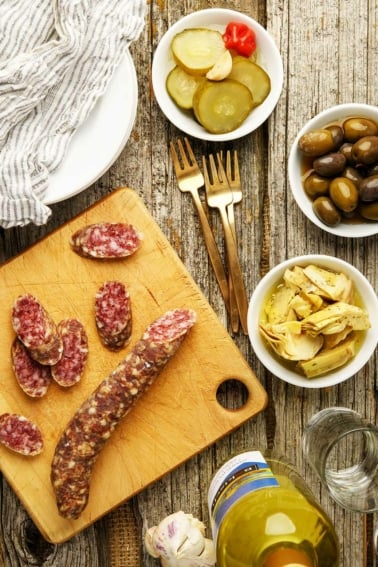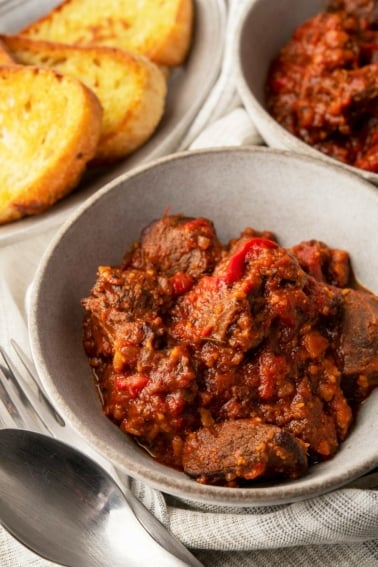As an Amazon Associate I earn from qualifying purchases.
Pulpo a la gallega. Man, is this good! I can’t tell you when I first ate this Spanish classic, but it was probably sometime in my late teens, and probably at a Spanish restaurant on New Jersey’s Route 22 whose name escapes me now. But I remember it being real-deal Spanish — or at least what I imagined it might be, considering I’ve never been there.
Pulpo a la gallega is basically an octopus salad. Most octo-eating cultures have their versions, and the Spaniards are no different.

According to the late, great cookbook author Penelope Casas in her The Foods and Wines of Spain, “a la gallega” is from Galicia, and it means anything cooked with paprika and olive oil… to my mind, everything is good with paprika and olive oil, but octopus is especially good.
You will also find this recipe called pulpo a la feria, because it is common festival, or fair, food in Spain.
And while most octopus salads are summertime fare, pulpo a la gallega works in any weather, likely because Galicia is in the cold, northern part of Spain. I think it’s the paprika and garlic that gives you a warming feeling when you eat it.
And while yes, I often finish the octopus on the grill, I do live in California, where this is easily done all year. You can either grill or use the broiler — the point is to get a little char on the octopus. If you use the broiler, keep an eye on things because while a little char is good, a lot will ruin the dish.
(I also have a straight-up grilled octopus recipe.)
Once the octopus is ready, you toss is in olive oil with paprika, a little cayenne, salt and black pepper and squeeze lemon juice or sherry vinegar on it.
Pulpo a la gallega is a perfect tapas dish, party appetizer or hell, just something to chew on with crusty bread while watching football. If you want to make this part of a cool Spanish tapas feast, I’d whip up some salt cod fritters to go alongside it, as well as boquerones and maybe even quail or partridges en escabeche.
Pulpo a la Gallega, Spanish Octopus with Paprika
Ingredients
- 2 to 3 pounds octopus
- 1 bunch of parsley
- Tops from a fennel bulb
- 1 sprig oregano
- 2 to 3 green onions, chopped roughly
- 2 bay leaves
- 4 garlic cloves, crushed and minced
- 1/2 cup extra-virgin olive oil
- 1 tablespoon paprika
- 1 teaspoon smoked paprika (optional)
- 1/4 teaspoon cayenne
- Salt and black pepper
- Lemon wedges to serve
Instructions
- First you'll need to tenderize the octopus. Boil a large pot of salty water. Cook the octopus for 2 minutes, then remove to a cutting board. While the octos are cooling turn the oven to 225°F.
- Line a heavy, lidded pot with the parsley, fennel fronds, oregano, green onions and bay leaves. Trim fatty bits from the octopus and clean out the heads (normally this last step has been done for you, but not always). Cut the octopi into large pieces and nestle into the pot of greens. Cover the pot and cook for 90 minutes to 4 hours, depending on how large and tough the octopi are. I typically shoot for 2 hours. Don't worry about the lack of liquid in the pot: The octos will release enough to make a flavorful broth.
- When the octopus is tender, remove from the pot and cut into serving-sized pieces. Coat with some of the olive oil and either grill or broil until you get some char marks, about 8 to 10 minutes.
- Toss the octopus with the rest of the olive oil, garlic, the paprika, smoked paprika and cayenne. Add salt and black pepper to taste and serve with lemon wedges, at room temperature or slightly warm. Serve with bread.
Nutrition
Nutrition information is automatically calculated, so should only be used as an approximation.





Thank you for your recipe! I’m very excited to try it out. One question: When you wrote ‘While the octos are cooling, turn the oven to 225°F,’ does that mean the octopus goes into the oven for about 2 hours in the lidded pot, or is this a typo and it should be boiling for about 2 hours?
Denise: The octopus only boils a minute or two. It does most of its cooking in the lidded pot in the oven.
The protein listed for this recipe is 1 gram. Is this a typo? I think octopus has more than 1 gram of protein.
can you pre cook day before then day of dinner party at to grill?
Giuliana: Absolutely.
Hi Hank! Thanks for a great looking recipe. I’m hoping to prepare this for a large dinner gathering and was hoping to do some prep in advance. Would it be possible to do the braise the day before, store the fully cooked octopus overnight, and then finish on the the grill day-of? Or would that impart some off flavors/textures?
Thanks again!
Mark: Absolutely. That will work well.
hi, loved this recipe! also, i visit family in new jersey quite often and i think the spanish restaurant you mentioned is spanish tavern in mountainside 🙂
So I bought 2 ponds of cooked octopus, how can I adjust the recipe with already cooked? Will I sill need Tenderize it?
Claire: It’s already cooked? Huh. OK, then just simmer it in the final sauce.
Hi Hank, how would you change this up to cook on the Traeger?
Jason: This is not a good recipe for that. I would stick to the recipe as is.
Okay got it and will do Hank scored some fresh Spanish Pulpo from the market day and stubbled upon your recipe, thank you sir!
I’ve never cooked octopus before. Are you using the head too or just the legs? Is there an optimal size octopus you suggest trying to buy? Thanks.
Lillian: Yes, I use the head, too. No optimal size, but the larger the octo, the longer it will take to get tender.
Hi Hank, Once the octopus is cooked in oven, could you then pickle the octopus?
Dominika: Probably, but I have never tried this.
Hank: also I have heard that a copper penny should be placed in the pan when sauteeing the ocopus – is this another old fisherman’s tale like adding a cork to the boiling water?
Vincent: That one is an old wives’ tale. Cook the octo like I suggest and you will be happy. 🙂
I agree that pulpo is one of the best eting delights. I first discovered this fact t Rincon de Espana on Thompson Street in New York City’s Greenwich Village – “Pulpo a la Carlos. The octo was so butter smooth and tasty – seemed to be a sautee with garlic, onion, sherry and Spanish paprika. Have you heard about tenderizing the octo by “scaring” it, i.e., dunking the critter three times before dropping it into the boiling water? Is this technique truth or nonsense? Can’t wait to try your recipe! About that freezing the octopus technique: most of it comes to the market frozen, then it’s defrosted – will refreezing be a disaster? Thanks, so much. Vince
Sorry might have missed it, but where does the garlic come into play? In the Dutch oven? Or during the grilling/broiling? Just courious, I don’t see it in the instructions, but it’s in the ingredients. Thanks!
Matt: I fixed the recipe – thanks for the catch! It goes in at the end.
Omg…I made this and it was the best. My husband and I devoured the entire octopus in one sitting. Thanks for the recipe
Hi there, do you use Spanish sweet paprika plus the smoked? Thanks!
Becca: Yep. I use both.